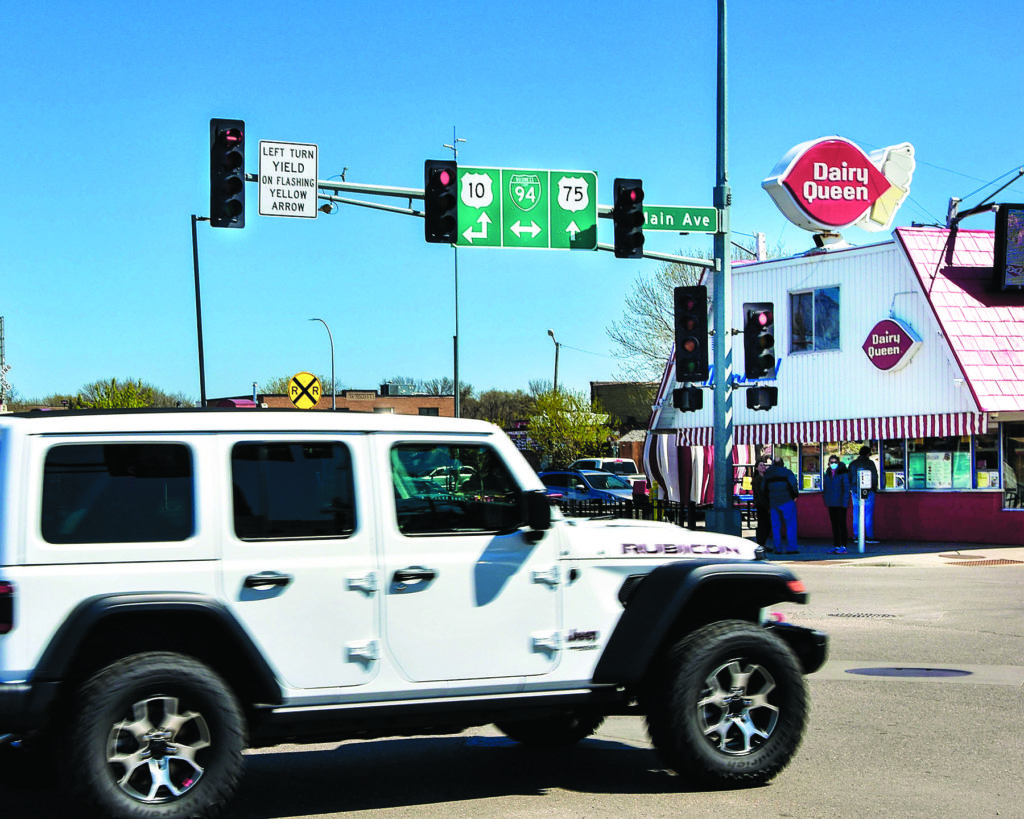
Nancy Edmonds Hanson
nancy.edmonds.hanson@gmail.com
It’s still a long way down the road, but the long-discussed reworking of in-town stretches of U.S. Highways 10 and 75 came into sight Monday, when a Minnesota Department of Transportation consultant unveiled the result of years of study to the Moorhead City Council.
The long-anticipated rebuild won’t begin for five more years, with actual construction slated for 2025-2026. But Leif Garnass of SRF Consulting shared key points for reconstructing and upgrading the arterial routes that criss-cross the heart of the city. Highway 10 follows Main and Center Avenues throughout downtown and on toward Dilworth and beyond, while north-south Highway 75 follows Eighth Street from the southern edge of the city to Center, then jogs east before turning north again near 21st Street.
Garnass told council members that 1,250 residents have taken part in an exhaustive series of meetings, presentations, focus groups and public events, including an online survey of their concerns and suggestions. He noted that the project includes an unusually broad range of environments, from the stately tree-lined yards along Eighth to the high-density commercial and residential area developing downtown, and the rural highway-like stretch of Highway 10 headed toward Dilworth, with its deep ditch median.
The most high-profile change in the plan is the recommendation to reduce Main Avenue’s present five lanes from the Red River to Eighth Street down to just three, extending the similar change already put in place west of the river. The lane reduction would make room for on-street parking and enhanced routes for pedestrians and bicyclists both for esthetics – “creating a gateway setting for a key entrance to Minnesota,” Garnass said – and safety. The proposed 11th Street railway underpass may also affect planning, he said; it’s currently MnDOT’s number-one statewide priority, but the projected state budget deficit leaves its future unclear.
The nature of Center Avenue, too, is slated for redesign to coordinate with downtown Moorhead’s redevelopment. The consultant suggested the three-lane configuration will make it more pedestrian- and bike-friendly, with slower traffic and wider sidewalks.
As for Highway 75 along Eighth Street, he reported that participants in the survey and focus groups complained of its “highway feel” and made a plea for safer pedestrian crossings, as well as preservation of trees along the boulevards. Some comments favored eliminating the roadway jogs at Fourth and Fifth Avenues South, as well as consistent continuation of the bike paths all the way to the I-94 underpass.
Garnass noted that beyond downtown, the remainder of the Highway 10 presents a different kind of challenge as it passes through a largely industrial and commercial area. “Many told us they’d like to see a more urban feel,” he said, with pedestrian and bike paths on both sides and an underpass for safe crossing through the Highway 10/Highway 75 interchange.
The full US10/US75 study can be viewed at www.fmmetrocog.org/projects-rfps/us-1075-corridor-study/. Public input is being collected there through May 21.
Dog park taking shape
Plans for the southside dog park are shaping up. The council approved a conditional use permit for the hound playground’s final site in River Oaks Park. The next step is the issuance of a call for bids for excavation, fill and fencing work at the site at 100 River Oaks Point, which occupies the western section of parkland jutting out into a bend of the Red River.
The dog park has run into several obstacles since the council gave the Parks and Recreation Department the go-ahead last fall. Its original and preferred footprint ran up against FEMA rules prohibiting permanent construction on the properties that were bought out after the flood of 1997. The favored location was scrapped, and the dog park was resituated from the department’s first, less flood-prone location to the more distant area.
While the parks budget includes $40,000 to cover fencing and other immediate costs, completion of planned facilities for canines and their keepers depends on public support. It is one of the five dreams in the city’s “wish book” powered by the young Moorhead Community Foundation. The fund-raising campaign was on the verge of being launched earlier this spring, beginning with a kick-off at the Mutt March. Then Covid-19 happened.
Parks director Holly Heitkamp emphasized that plans are still going forward – just not quite as fast or as aggressively as supporters had originally envisioned. Her department and volunteers are still looking for contributions from individuals and groups. Just one has been received so far: $1,000 from governmental affairs director Lisa Bode.


